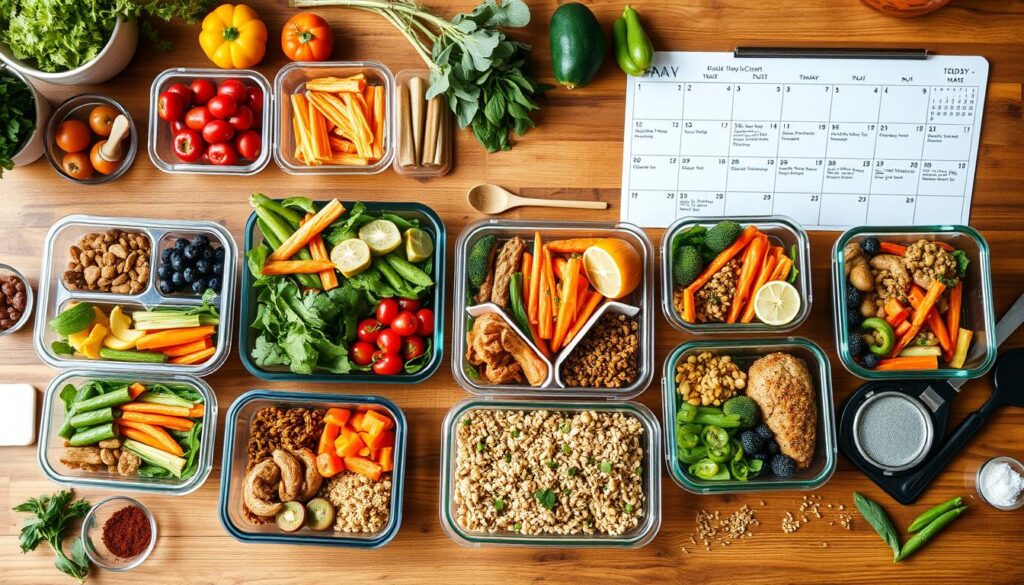Changing how you plan meals can be a big win for eating healthy. Batch cooking is a great way for busy people to get tasty, nutritious meals without the daily kitchen hassle. This guide will show you a new way to prepare meals that saves time, cuts down on cooking fatigue, and keeps your diet fresh and varied.
Meal planning is more than just cooking ahead. It’s about making a smart plan for your nutrition that fits your life. Our one-week recipe guide solves the daily dinner problem. It offers quick and tasty recipes to keep your meals exciting and fulfilling.
Key Takeaways
- Discover how meal planning can reduce daily cooking stress
- Learn techniques for efficient batch cooking
- Explore diverse recipes that prevent mealtime boredom
- Save money and time with strategic food preparation
- Maintain consistent healthy eating habits
Getting Started with Efficient Meal Prepping
Meal prepping turns kitchen chaos into a smooth process. It saves time, reduces stress, and makes meals tasty all week.
Starting with the right tools is key to meal prep success. Good tools make the process easier and more fun.
Essential Kitchen Tools and Equipment
For efficient meal prep, you need some important kitchen items:
- Food processor for quick chopping and mixing
- High-quality chef’s knife for precise cutting
- Large cutting boards
- Slow cooker for hands-off meal preparation
- Digital kitchen scale for accurate portioning
Storage Container Guidelines
Good food storage keeps meals fresh and prevents waste. Choose containers that are:
- Microwave-safe
- Leak-proof
- BPA-free
- Stackable for fridge organization
| Container Type | Best For | Durability |
|---|---|---|
| Glass containers | Hot meals, reheating | High |
| Plastic containers | Cold meals, salads | Medium |
| Stainless steel | Lunch transport | Very High |
Time-Saving Prep Techniques
Here are ways to save time in the kitchen:
- Batch cook staple ingredients
- Chop vegetables in advance
- Use multi-purpose ingredients
- Clean as you go
“Meal prepping isn’t about perfection, it’s about preparation.” – Unknown Meal Prep Expert
With these tools, storage, and techniques, meal prep becomes easy and stress-free.
Smart Shopping List and Ingredient Planning
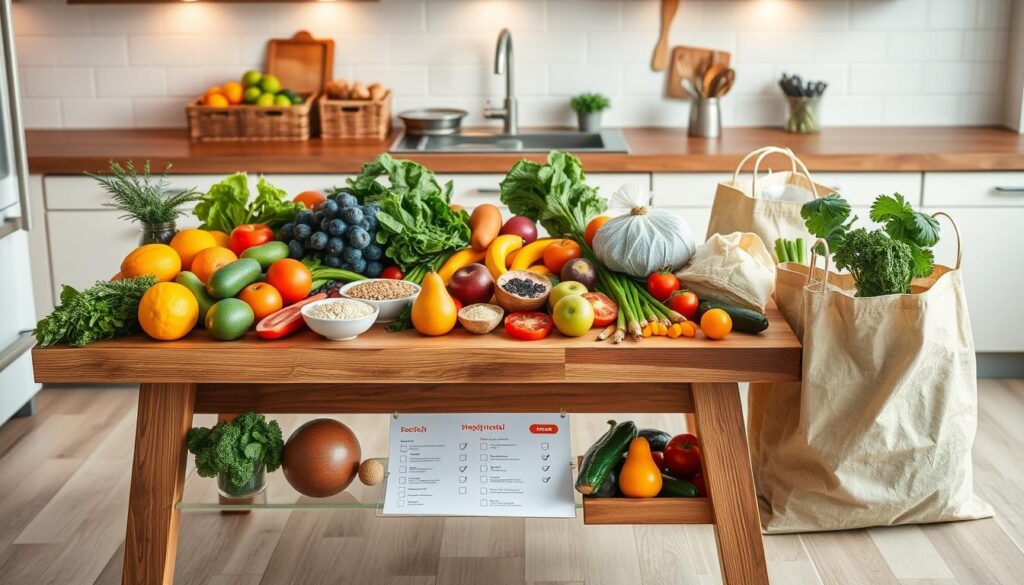
Effective meal planning starts with a smart shopping list. It makes your weekly meal prep easy and stress-free. The secret is choosing ingredients that are affordable and versatile.
“Plan your groceries like a pro, and you’ll save time and money!” – Meal Prep Experts
Start by organizing your shopping list into categories. This makes shopping faster and helps you avoid buying things you don’t need.
- Protein sources (chicken, eggs, tofu)
- Fresh produce
- Grains and starches
- Pantry staples
- Herbs and spices
Choose ingredients that can be used in many ways. Items like chicken breasts, quinoa, and mixed vegetables are great. They can be turned into many different meals.
| Ingredient | Cost-Effectiveness | Meal Versatility |
|---|---|---|
| Chicken Breasts | High | Salads, Stir-fries, Wraps |
| Brown Rice | Very High | Bowls, Side Dishes, Stuffed Peppers |
| Eggs | Extremely High | Breakfast, Lunch, Dinner Proteins |
Pro tip: Buy seasonal produce and purchase in bulk to maximize your budget-friendly ingredient strategy. Frozen vegetables and bulk protein can save you money. They keep your meals nutritious without breaking the bank.
Breakfast Meal Prep Ideas That Stay Fresh All Week
Mornings can be chaotic, but your breakfast doesn’t have to be. Meal prep for breakfast is perfect for busy people. It saves time, reduces stress, and gives you a healthy start to your day.
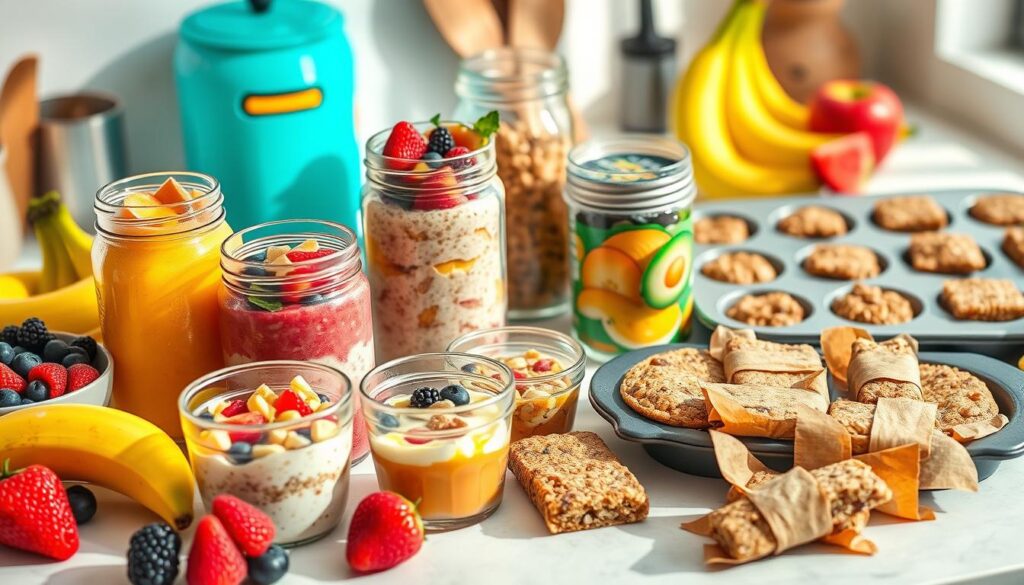
Spending a bit of time on the weekend can change your weekday mornings. Here are some smart ways to prep breakfast that keeps it fresh and tasty:
Make-Ahead Breakfast Bowls
Breakfast bowls are great because they’re full of nutrition and can be made ahead. Try these tasty mixes:
- Quinoa and roasted vegetable breakfast bowl
- Greek yogurt parfait with seasonal fruits
- Chia seed pudding with nuts and berries
Overnight Oats Variations
Overnight oats are a quick and easy breakfast option. You can make them in many ways to fit your taste:
- Peanut butter and banana
- Apple cinnamon
- Chocolate and almond
Protein-Packed Morning Options
Start your day with these high-protein breakfast ideas:
| Protein Source | Preparation Time | Storage Duration |
|---|---|---|
| Egg muffins | 20 minutes | 5 days |
| Tofu scramble | 15 minutes | 4 days |
| Protein smoothie packs | 10 minutes | 3 days |
“Preparation is the key to healthy morning meals. Spend a little time planning, and you’ll save a lot of time and stress during the week.” – Nutrition Expert
Pro tip: Always use airtight containers and refrigerate your prepped meals to maintain freshness and flavor.
One Week of Easy, No-Repeat Meal Prep Recipes
Creating a weekly meal plan doesn’t have to be hard. Our recipes make meal prep simple, so you can enjoy tasty, healthy food without getting bored. Let’s explore a seven-day journey that will change how you prepare meals.
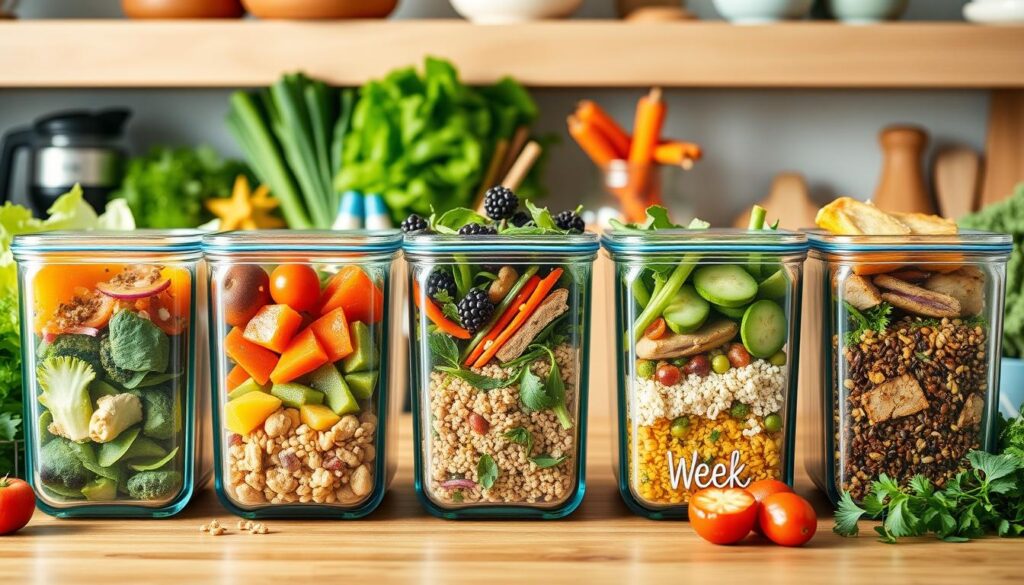
For a great weekly meal plan, mix things up and prep smart. We focus on dishes that are easy to make, full of flavor, and great for making in bulk.
- Monday: Mediterranean Quinoa Bowls
- Tuesday: Asian-Inspired Chicken Stir-Fry
- Wednesday: Vegetarian Black Bean Tacos
- Thursday: Salmon with Roasted Vegetables
- Friday: Italian Herb Frittata
- Saturday: Southwest Stuffed Peppers
- Sunday: Greek Lamb Meatballs
“Meal prepping is not about perfection, but about making healthy eating easier and more enjoyable.” – Nutrition Expert
Each recipe in this plan is quick to cook and full of nutrients. Spend a few hours on the weekend prepping, and you’ll have a week of easy, tasty meals.
| Day | Meal Type | Prep Time | Calories |
|---|---|---|---|
| Monday | Mediterranean Quinoa Bowl | 25 minutes | 450 cal |
| Tuesday | Asian Chicken Stir-Fry | 30 minutes | 400 cal |
| Wednesday | Vegetarian Black Bean Tacos | 20 minutes | 380 cal |
| Thursday | Salmon with Roasted Vegetables | 35 minutes | 500 cal |
| Friday | Italian Herb Frittata | 25 minutes | 350 cal |
| Saturday | Southwest Stuffed Peppers | 40 minutes | 420 cal |
| Sunday | Greek Lamb Meatballs | 35 minutes | 480 cal |
Pro tip: Invest in good quality storage containers and label each meal with the date to keep track of freshness.
Lunch Box Solutions for Work and School
Preparing packed lunches can change your day for the better. It’s easy to make healthy and tasty meals for work or school. The right steps can make your lunchtime better and help you stay healthy.
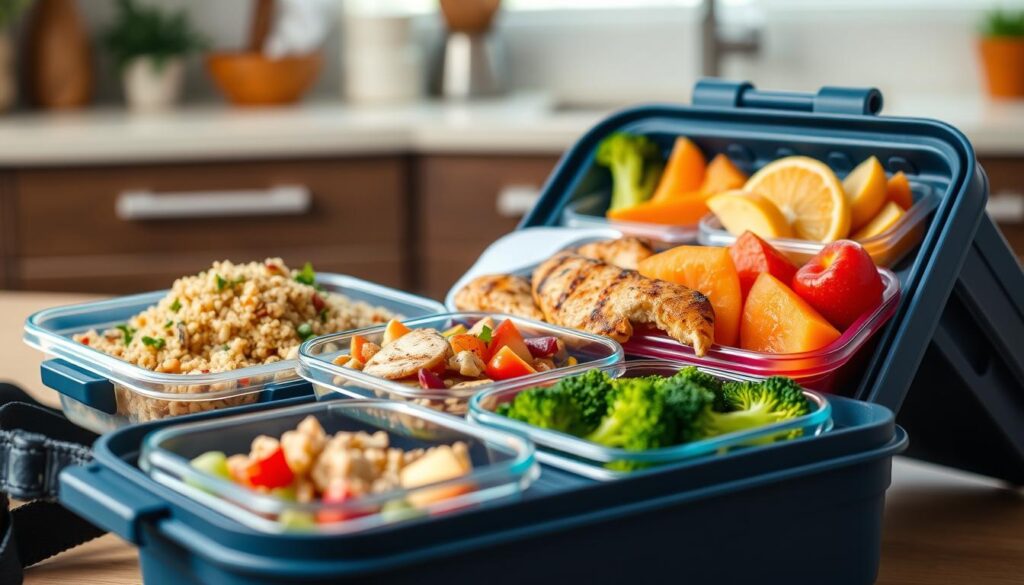
Balanced Lunch Combinations
Creating the perfect lunch is all about mixing the right nutrients. Aim for a balanced plate with:
- Lean proteins (grilled chicken, tofu, beans)
- Complex carbohydrates (whole grains, sweet potatoes)
- Fresh vegetables and fruits
- Healthy fats (avocado, nuts, olive oil)
Portion Control Guidelines
It’s important to control your portions to stay full and avoid eating too much. Here are some easy tips for packed lunches:
| Food Group | Recommended Portion |
|---|---|
| Protein | 3-4 oz (palm-sized) |
| Grains | 1/2 cup cooked |
| Vegetables | 1-2 cups raw or roasted |
| Fruits | 1 medium piece or 1/2 cup |
Packing Tips for Maximum Freshness
Keep your lunches fresh and tasty with these packing tips:
- Use insulated lunch bags with ice packs
- Separate wet and dry ingredients
- Choose leak-proof containers
- Pack dressings and sauces separately
“A well-prepared lunch is the secret to staying energized and focused throughout the day.” – Nutrition Expert
Pro tip: Invest in quality containers with compartments to keep your packed lunches organized and fresh.
Dinner Recipes That Reheat Well
Learning to make-ahead dinners can change how you plan meals. Batch cooking offers tasty, easy meals for busy people. These meals are just as good the next day.
Choosing the right meals to reheat is key. Look for dishes that keep their flavor and texture after chilling. Some recipes are perfect for making in bulk and serving many.
- Hearty casseroles
- Slow cooker stews
- One-pot pasta dishes
- Braised meats
- Grain-based bowls
For the best make-ahead dinners, store them in airtight containers. Eat them within 3-4 days for the best taste and safety.
“Great meal prep is about working smarter, not harder in the kitchen.” – Professional Chef
When reheating, use gentle, steady heat. This prevents drying out or overcooking. Try microwaving with a damp paper towel or reheating in a low oven to keep moisture and flavor.
Some proteins like chicken and beef can get tough when reheated. Use methods that keep them moist, like adding broth or sauce before warming.
Tip: Separate sauces and toppings when storing to keep ingredients fresh and prevent soggy textures.
Healthy Snack Prep Ideas
Getting ready for healthy snacks ahead of time can really help. It keeps your energy up and stops you from eating bad food. Quick, tasty, and healthy snacks can make your meal prep better and keep you full all day.
Energy-Boosting Options
For snacks that give you energy, it’s important to prepare them right. Here are some snacks that are full of nutrients and keep you going:
- Protein-packed trail mix with nuts and seeds
- Homemade energy balls with dates and chia seeds
- Hard-boiled eggs with paprika seasoning
- Greek yogurt parfaits with granola
Sweet and Savory Alternatives
Healthy snacks don’t have to be dull. Mix up sweet and savory snacks to keep your taste buds happy:
| Sweet Snacks | Savory Snacks |
|---|---|
| Apple slices with almond butter | Roasted chickpea clusters |
| Chia seed pudding | Mini veggie frittatas |
| Frozen berry yogurt bites | Cucumber rounds with hummus |
“Snacking smart is about fueling your body with nutrition, not just filling an empty space.” – Nutrition Expert
Preparing these snacks early means you always have healthy choices. Put them in containers for easy grabbing. This makes eating healthy easy and fun.
Storage and Reheating Guidelines
Learning how to store food is key to keeping your meal prep fresh and safe. The right storage can make your meals last longer and stay tasty all week.
“The key to great meal prep is not just in the cooking, but in the storage and reheating process.”
Knowing how to reheat food can turn a good meal into a great one. The right storage keeps flavors, textures, and nutrients intact.
- Refrigerate prepared meals within 2 hours of cooking
- Use airtight containers to prevent moisture and bacterial growth
- Label containers with preparation dates
- Store different food types separately to maintain quality
Each food type needs its own storage method. This affects taste, texture, and safety.
Optimal Storage Timeframes
| Food Type | Refrigerator Storage | Freezer Storage |
|---|---|---|
| Cooked Meats | 3-4 days | 2-6 months |
| Cooked Grains | 4-5 days | 1-2 months |
| Roasted Vegetables | 3-5 days | 3-6 months |
When reheating, make sure food hits 165°F to be safe. Use microwave-safe containers and stir food halfway through to heat evenly.
- Avoid repeated reheating of the same dish
- Use low to medium heat settings
- Add a splash of water to prevent drying out
Pro tip: Invest in quality glass or BPA-free plastic containers with secure lids to maximize your meal prep longevity and food safety.
Budget-Friendly Meal Prep Strategies
Affordable meal prep doesn’t mean you have to give up taste or nutrition. With smart planning and shopping, you can make tasty, healthy meals without spending a lot. Learning to cook on a budget is easy with the right methods.
Smart Cost-Cutting Tips
To save money on meals, think creatively and use practical tips. Here are some ways to cut costs:
- Buy proteins in bulk and freeze portions
- Choose cheaper protein alternatives like beans and eggs
- Purchase generic brands instead of name-brand products
- Use frozen vegetables when fresh are expensive
- Plan meals around sales and discounts
Seasonal Shopping Guide
Seasonal ingredients are key to saving money on meals. Eating produce during its peak season means lower prices and better taste. Local farmers markets often have the best deals on fresh, seasonal foods.
“Seasonal cooking is not just economical—it’s a celebration of nature’s rhythm and flavor.”
Here’s a quick guide for buying seasonal produce:
| Season | Recommended Ingredients | Estimated Cost Savings |
|---|---|---|
| Spring | Asparagus, artichokes, strawberries | 20-30% cheaper |
| Summer | Tomatoes, zucchini, peaches | 25-35% cheaper |
| Fall | Squash, apples, pumpkins | 15-25% cheaper |
| Winter | Citrus, root vegetables, kale | 20-30% cheaper |
By using these budget cooking tips, you can make meal prep both affordable and fun.
Common Meal Prep Mistakes to Avoid
Meal prepping can change your life if you do it right. But, many people make mistakes that ruin their efforts. Knowing these errors can help you make better meals, save time, and money.
Here are the most common mistakes that can mess up your meal prep:
- Overcrowded Refrigerator Syndrome: Making too much food can lead to waste and safety issues
- Not storing ingredients properly
- Not controlling portion sizes
- Not keeping track of meal freshness
Keeping food safe is key when you prep meals. Don’t let perishables sit out for more than two hours. Use tight containers and mark them with when you made them.
“Smart meal prep is about quality, not just quantity” – Professional Nutritionist
To get better at meal prep, try these tips:
- Plan meals that use similar cooking methods
- Buy good storage containers
- Learn how to keep food fresh
- Make meal plans that are balanced and varied
Avoiding these mistakes will help you cook more efficiently. You’ll save time, feel less stressed, and enjoy healthier meals.
Conclusion
Starting meal prep changes more than just how you cook. It brings big benefits that go beyond just food. You’ll save time and stay healthy, even when your week gets busy.
Managing your time gets easier with meal prep. A little effort on the weekend can make your daily meals less stressful. You’ll enjoy everything from breakfast bowls to quick lunches, feeling good about your choices.
Don’t worry if you’re not perfect at meal prep. Begin with small steps, try new recipes, and grow your skills. The best strategies are ones you can keep up with, helping you stay healthy and happy.
Meal prep is a journey, not a race. Each week, you can try new recipes and improve your routine. You’ll be making a smart choice for your health and daily life.
FAQ
How long can I store meal-prepped food in the refrigerator?
You can store meal-prepped food in the fridge for 3-5 days. Cooked proteins like chicken and fish last 3-4 days. Some veggie dishes can last up to 5 days. Always use airtight containers and check for spoilage before eating.
Can I freeze my meal-prepped dishes?
Yes, you can freeze many meal-prep dishes. Most can be frozen for 2-3 months. A tip: Freeze meals in individual portions. Use freezer-safe containers or bags to avoid freezer burn.
What are the best containers for meal prepping?
Choose glass or BPA-free plastic containers with tight lids. Compartmentalized containers are good for separating foods. Pyrex and OXO offer great options that are safe for microwaves, dishwashers, and freezers.
How can I prevent my meal-prepped food from getting soggy?
Keep wet and dry ingredients apart until you eat. Store salad dressings in small containers. For grain bowls, place crunchy elements on top or separate until serving.
Is meal prepping cost-effective?
Meal prepping can cut your food costs by 30-50%. Buying in bulk, reducing waste, and avoiding takeout saves money.
How do I ensure my meal-prepped food stays fresh?
Cool foods before storing, use airtight containers, and keep them in the fridge’s coldest spot. Follow the first in, first out rule. Store prepared meals away from raw ingredients to avoid contamination.
Can I meal prep if I have dietary restrictions?
Yes, meal prepping is very flexible. You can adjust recipes and ingredients to fit your dietary needs, whether vegan, gluten-free, keto, or others.
How much time does meal prepping actually save?
Meal prepping saves 5-10 hours a week. A 2-3 hour prep session on the weekend can give you meals for the week, saving daily cooking time.
What kitchen tools are essential for meal prepping?
You’ll need a food processor, slow cooker, good chef’s knife, cutting boards, measuring cups, containers, and baking sheets. These tools make prep work easier and faster.
How can I add variety to my meal-prepped dishes?
Try new seasonings, marinades, and cooking methods. Change up your protein sources and explore different cuisines. Use versatile ingredients that can be transformed with spices and techniques.
Share this post: on Twitter on Facebook

